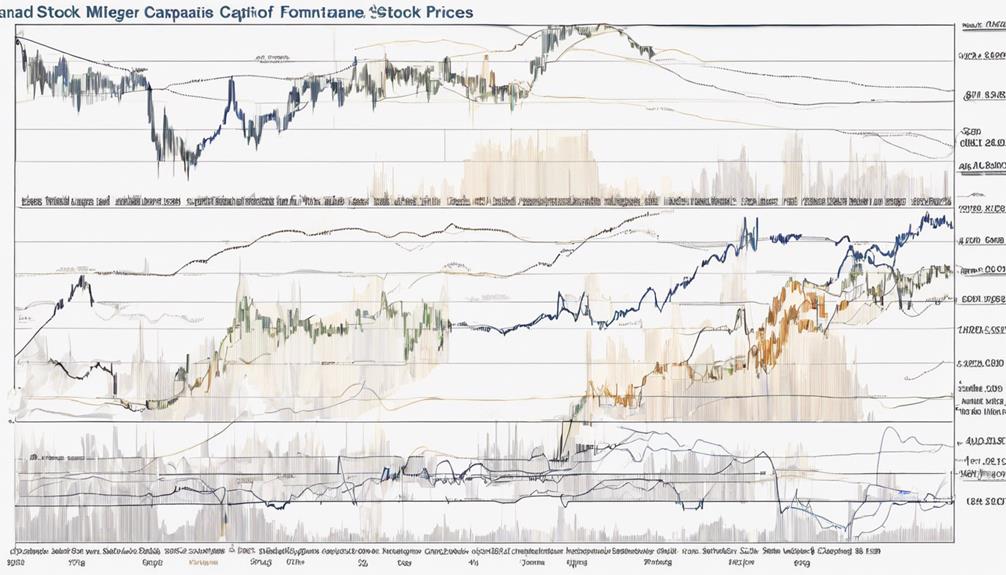Analyzing the Benefits of Stock Mergers

Stock mergers bring significant advantages to shareholders. One key benefit is the deferral of capital gains taxes in stock-for-stock transactions, enabling companies to allocate those funds towards reinvestment.
Moreover, the consolidation of operations uncovers synergies and cost efficiencies, ultimately enhancing profitability. Shareholders not only become partial owners of the merged entity but also stand to benefit from its prospective success.
Additionally, stock mergers bolster market dominance by increasing scale and resource capabilities. Understanding the strategic rationale and financial gains associated with these transactions sheds light on their compelling nature.
Delving into the intricacies of structuring and integrating successful stock mergers can offer further valuable insights.
Key Takeaways
- Stock-for-stock mergers enable shareholders of the target company to become part owners of the new, combined entity. This ownership stake allows them to share in the potential success and growth of the merged company.
- When companies merge, it creates a platform for collaboration, drives innovation, and increases the overall value for shareholders. By integrating operations and finding synergies, cost savings can be achieved, further enhancing the value of the combined entity.
- Stock mergers come with tax advantages that are beneficial for shareholders. Capital gains taxes can be deferred, and the risk of double taxation can be avoided, providing a financial benefit for those involved in the merger.
- Diversification through mergers helps to reduce the volatility of the market risks and can lead to improved profitability for the combined entity. By combining different business lines or industries, the overall risk can be spread out more effectively.
- To fully realize the benefits of stock mergers, it is crucial to have a well-thought-out post-merger integration strategy. Effective communication, goal alignment, and a clear plan for moving forward are essential for ensuring the success of the merger and maximizing the benefits for all stakeholders involved.
Defining Stock-for-Stock Mergers
A stock-for-stock merger happens when one company buys another company by trading its own shares for the shares of the target company. In this type of merger, the shareholders of the target company become shareholders of the combined entity. The exchange ratio in stock-for-stock mergers determines how many shares of the acquiring company are exchanged for each share of the target company.
Stock-for-stock mergers are often structured as tax-free transactions, which can provide potential tax advantages for both companies involved. Shareholders can benefit from the future success of the combined entity in these mergers. By exchanging their shares, they become owners of the new, combined company, giving them a stake in its potential growth and profitability.
This transfer of ownership helps integrate the two organizations, creating a collaborative environment that can drive innovation and enhance shareholder value in the long run.
Rationale Behind Stock-for-Stock Transactions
Stock-for-stock transactions offer companies the opportunity to merge without incurring immediate tax liabilities. By exchanging shares instead of cash, companies can potentially defer capital gains taxes that would be triggered in a cash transaction. This tax advantage is a key driver for companies considering this type of merger.
Additionally, stock-for-stock transactions can lead to operational synergies and cost savings. When two companies combine, they may be able to streamline operations, eliminate duplicate functions, and reduce overall expenses. This can result in a more efficient and profitable combined entity, creating value for shareholders in the long run.
Tax-Efficient Consolidation
Stock-for-stock mergers are often chosen by companies due to their tax-efficient nature, allowing businesses to consolidate without immediate tax obligations. These mergers provide tax deferral benefits by delaying gains recognition and potentially avoiding double taxation.
Choosing a stock deal structure can result in long-term capital gains treatment for shareholders, offering potential tax advantages. Seeking advice from tax professionals can help companies maximize the tax benefits of stock-for-stock mergers, enhancing the financial outcomes of the transaction.
The tax-efficient consolidation through stock-for-stock mergers can significantly contribute to overall financial advantages, making it an attractive option for companies looking to merge operations. This strategic approach not only streamlines business operations but also helps in deferring or minimizing tax liabilities, making it a popular choice for innovative organizations.
Synergistic Business Integration
Synergistic business integration is the cornerstone of stock-for-stock transactions, where companies aim to combine their complementary strengths and capabilities. The strategic rationale behind these mergers is to leverage synergies for cost savings, revenue growth, and operational efficiencies. By integrating their business operations, companies can create a stronger, more competitive entity in the market.
This synergistic integration strategy focuses on maximizing the benefits of combining resources, technologies, and market access. By capitalizing on economies of scale, eliminating redundancies, and enhancing overall competitiveness, companies can achieve greater success. Successful business integration in stock-for-stock mergers can result in improved financial performance and increased shareholder value.
The key to unlocking the full potential of these transactions lies in effective synergy capture. Through a systematic integration process, companies can harness the value inherent in these strategic combinations. The ultimate outcome is a more resilient and agile organization poised for long-term success in the market.
Synergies and Cost Efficiencies

Stock mergers harness the potential of synergies by combining the strengths, capabilities, and resources of both companies, leading to improved overall performance. By integrating complementary functions, optimizing operations, and reducing unnecessary expenses, significant cost efficiencies can be achieved.
These synergies and cost savings have a direct impact on the company's bottom line, resulting in increased profitability and enhanced shareholder value.
Furthermore, diversification through mergers can help reduce dependence on single markets, thereby lowering risks associated with market volatility.
Increased Market Dominance
By merging stocks, we can strengthen our market dominance by combining the resources, customer bases, and market shares of the companies involved. This consolidation enhances our competitive position, giving us more control over pricing and better negotiation power in the industry. With a larger market share, we can leverage our unique strengths to outperform our rivals.
The increased market share resulting from these mergers enables us to achieve greater economies of scale and cost efficiencies, leading to higher profitability. Investors looking for exposure to a top player in the industry are likely to be attracted to our reinforced market dominance, potentially increasing the value of our stock.
These strategic stock mergers help us solidify our position as a dominant force in the industry, reaping the benefits of enhanced pricing power, improved cost structures, and increased investor interest. By pursuing these mutually beneficial opportunities, we can establish ourselves as the preferred provider in our market.
Shareholder Considerations in Stock Mergers

Shareholders are pivotal in the success of stock mergers, as they receive shares of the acquiring company in exchange for their current holdings. The exchange ratio, determining how many acquiring company shares each shareholder gets per target company share, is a critical factor in this process.
Shareholders can reap various benefits from stock mergers, including the potential for long-term gains from the combined entity's success, tax advantages like deferral and avoidance of double taxation, and the chance to enhance shareholder value through fair exchange ratios and possible synergies.
It's essential to recognize that shareholders are deeply interested in these aspects, as they can significantly influence the overall value of their investment.
Striking a balance between a fair exchange ratio and the potential for increased market dominance and synergies is vital for maximizing shareholder value in stock mergers. By carefully considering shareholders' needs and interests, successful mergers can be crafted that benefit all stakeholders.
Tax Implications of Stock-for-Stock Deals
When talking about the tax implications of stock-for-stock deals, the situation looks pretty positive. We've the option to delay paying taxes on any gains by using basis carryover provisions.
This means shareholders can hold off on recognizing their profits until they sell their shares in the future. Furthermore, the shares received from the acquiring company in the merger can potentially lead to long-term capital gains for shareholders, resulting in substantial tax savings.
It's advisable to seek advice from tax professionals to make the most of these tax benefits and ensure a smooth and financially advantageous transaction.
Deferment of Taxable Gains
Stock-for-stock deals offer a tax-deferred advantage that allows investors to delay capital gains taxes until they decide to sell the acquired shares. This strategy provides flexibility in managing tax obligations and maximizing long-term gains.
By utilizing the Continuity of Interest Doctrine, shareholders participating in such mergers can engage in a tax-efficient exchange of shares without triggering immediate tax liabilities.
The benefits of this approach include deferring taxable gains to a later date, which can be advantageous for investors seeking to effectively manage their tax burden. Furthermore, maintaining ownership in the combined entity without facing an immediate tax event can be financially beneficial.
Basis Carryover Provisions
In stock-for-stock deals, the basis carryover provision allows shareholders to retain the original cost basis of their shares in the acquiring company. This provision is advantageous as it helps in deferring immediate capital gains taxes. By maintaining the original cost basis, shareholders can delay recognizing any gains until they decide to sell the new stock received after the merger.
The tax-deferred nature of basis carryover can potentially lead to long-term capital gains treatment in the future. Understanding the details of this provision is crucial for maximizing the benefits of stock-for-stock deals. These provisions are designed to reduce tax obligations and offer valuable tax advantages to shareholders.
Exploring the nuances of basis carryover provisions is essential for optimizing the tax implications of stock mergers. By taking advantage of these provisions, shareholders can enhance their overall financial outcomes and potentially benefit from favorable tax treatment in the long run.
Impact on Valuation and Stock Prices

Stock mergers can significantly impact the valuation and stock prices of the companies involved, reflecting the exchange ratio agreed upon in the deal. The stock prices of the merging firms can experience substantial fluctuations based on market reactions and investor sentiment towards the transaction.
When investors view the merger positively, it can lead to an increase in stock prices as they anticipate the potential benefits of the combined entity. On the other hand, if there's negative sentiment surrounding the merger, it may result in a decline in stock prices post-announcement, indicating market skepticism towards the strategic rationale or execution of the deal.
Ultimately, the exchange ratio and terms of the stock merger are crucial factors in determining the effect on the valuation and stock prices of the companies involved.
Investors evaluating the benefits and risks of a stock merger should consider these dynamics. By carefully assessing the potential impact on valuation and stock prices, informed decisions can be made regarding the merits of the transaction.
Regulatory Oversight in Stock Mergers
Regulatory oversight is crucial in stock mergers to ensure compliance with antitrust laws, which are designed to promote fair competition and protect consumers. Securities regulations also require the accurate disclosure of information to maintain transparency and fairness throughout the merger process. Understanding the tax implications is equally important, as having a clear grasp of the potential financial impact can significantly influence the success of a deal.
Antitrust laws are essential in preventing anticompetitive behaviors that could negatively impact the market and consumers. Regulatory bodies meticulously examine mergers to prevent the creation of monopolies or any unfair consolidation of power.
Likewise, securities regulations mandate the comprehensive disclosure of all pertinent information to instill trust and confidence in the merger process.
In essence, regulatory oversight ensures that stock mergers adhere to legal requirements, uphold fair competition, and provide the necessary transparency for all stakeholders involved. By upholding these standards, the full benefits of mergers can be realized while safeguarding the integrity of the market and the interests of all parties.
Risks and Challenges of Stock-for-Stock Mergers

In stock-for-stock mergers, it's crucial to consider the valuation differences between the companies involved and the challenges of integrating their cultures. Effective valuation methods and strategic change management are essential for a successful merger.
Stock-for-stock mergers involve exchanging shares of one company for shares of another, rather than using cash. This type of merger can be complex due to the need to accurately assess the value of each company's stock and ensure a fair exchange ratio. Valuation expertise is key to determining the right terms for the merger and avoiding potential conflicts over the exchange rate.
Cultural integration is another critical aspect of stock-for-stock mergers. When two companies come together, their organizational cultures may differ in terms of values, communication styles, and ways of working. It's important to address these differences early on and develop a plan for integrating the cultures harmoniously to avoid conflicts and ensure a smooth transition.
Valuation Discrepancies
Valuation differences often arise in stock-for-stock mergers, posing risks and challenges to the success of the deal. These discrepancies stem from varying perceptions of the value of each company, making it challenging to agree on a fair exchange ratio.
The complexities of accounting for intangible assets and market fluctuations can further complicate the valuation process, impacting the perceived worth of the merging entities.
The risks of overvaluation or undervaluation can significantly affect shareholder value and jeopardize the overall transaction. To address these risks, thorough due diligence, transparent communication, and reaching a mutually acceptable exchange ratio are essential.
This necessitates a solid grasp of financial analysis, strategic decision-making, and effective negotiation skills to navigate the valuation discrepancies successfully.
By understanding the nuances of valuation in stock mergers and taking proactive steps to mitigate risks, companies can enhance the chances of a successful and mutually beneficial merger.
Transparent communication and a collaborative approach are key to aligning on a fair exchange ratio that reflects the true value of each entity involved.
Integration Complexities
Integrating two distinct corporate cultures in a stock-for-stock merger can be a daunting task, requiring alignment of divergent values, norms, and behaviors to ensure a cohesive and productive workforce. Additionally, there's a risk of ownership dilution for existing shareholders due to the issuance of new shares, potentially reducing their proportional stake in the combined entity.
Navigating the regulatory landscape and legal complexities is also crucial to maintain compliance and avoid costly delays. To address these challenges, it's essential to implement incentive programs and establish clear communication strategies that engage employees across all levels.
Determining a fair exchange ratio is equally important in preserving shareholder value and satisfaction throughout the merger process. By proactively managing these integration complexities, organizations can maximize the benefits of stock-for-stock mergers and create a unified, high-performing entity.
Case Study: Successful Stock-for-Stock Integration
Even though Company X and Company Y were fierce rivals in the industry, their successful stock-for-stock merger brought significant benefits to both sets of shareholders. By capitalizing on the synergies between the two companies, they were able to achieve remarkable results:
Shareholders of Company Y saw a 20% increase in their investment value following the merger. The combined entity experienced a 30% decrease in operational costs, leading to enhanced profitability. The stock-for-stock integration also led to a 15% expansion in market share for the newly formed company. Company X's revenue received a substantial 40% boost after the successful stock merger with Company Y.
These impressive outcomes highlight the immense value that strategic mergers and acquisitions can bring. By combining their complementary strengths and efficiently integrating operations, companies can unlock synergies that drive exceptional growth and enhance shareholder returns.
The success of this stock-for-stock merger underscores the power of collaborative innovation and the potential for transformative change in today's dynamic business landscape.
Negotiating Stock-for-Stock Merger Terms

When negotiating stock-for-stock merger terms, it's essential to meticulously calculate the exchange ratio of shares between the acquiring and target companies. This crucial step involves assessing the valuations, synergies, and strategic fit of the proposed merger to ensure a fair deal for both parties. Shareholders' interests should be the top priority, and optimizing the potential value and gains from the merger is key.
In these negotiations, it may be necessary to consider incorporating cash or other securities into the deal, depending on the financial positions of the companies involved. This adaptability allows for the creation of a fair agreement that suits everyone involved. Successful negotiation of the stock-for-stock merger terms can ultimately result in increased shareholder value and long-term advantages for the combined entity.
Our primary focus remains on fostering innovation and identifying the most advantageous path forward. By carefully examining the critical factors involved, we can navigate the complexities of these mergers and achieve the best possible outcomes.
Post-Merger Integration Strategies
Successful post-merger integration strategies rely on effectively combining operations, systems, and cultures to achieve synergy and maximize efficiency in the newly formed entity. Clear communication, employee engagement, and goal alignment are essential for a smooth merger.
Integration teams play a crucial role in coordinating activities, resolving conflicts, and driving the integration process forward. Proper planning, timeline management, and continuous evaluation are necessary for successful execution. Implementing best practices, monitoring key performance indicators, and addressing challenges promptly are vital components of the integration process.
In a stock merger, where one company's stock is exchanged for another company's stock, the focus shifts to financial implications and shareholder value. Stock mergers can lead to increased market capitalization, improved financial performance, and enhanced competitiveness in the industry. By aligning the interests of shareholders and ensuring a smooth transition, companies can realize the full benefits of a stock merger.
Future Trends in Stock-for-Stock Mergers

Looking ahead, the landscape of stock-for-stock mergers is set to undergo significant changes. One notable trend on the horizon is the growing prevalence of cross-border mergers and acquisitions. Companies are increasingly looking to expand their global reach and tap into new markets through these strategic combinations. This shift towards international mergers reflects a broader trend of globalization in the business world.
In addition, technology firms are playing a key role in driving innovation and growth through stock mergers. By leveraging their respective strengths and resources, these companies are able to enhance their competitive edge and adapt to the fast-paced digital landscape. This trend underscores the importance of synergy and collaboration in the evolving market environment.
A noteworthy development in the realm of stock-for-stock mergers is the rising emphasis on environmental, social, and governance (ESG) factors. Investors and stakeholders are placing greater importance on sustainability and ethical practices, influencing the decision-making process in mergers. This shift towards ESG considerations highlights a broader shift towards responsible and conscientious business practices in the corporate world.
Furthermore, non-traditional sectors such as healthcare and renewable energy are increasingly exploring stock mergers as a strategic growth avenue. By diversifying their portfolios and expanding into new industries, companies in these sectors are positioning themselves for long-term success and resilience in a rapidly changing market landscape. This trend demonstrates the adaptability and forward-thinking mindset of businesses in today's dynamic environment.
The emergence of special purpose acquisition companies (SPACs) is also reshaping the merger landscape, offering companies new avenues for growth and strategic partnerships. This alternative approach to mergers provides flexibility and agility in navigating the complexities of the market, opening up exciting possibilities for companies looking to expand their horizons.
As the field of stock-for-stock mergers continues to evolve, it's crucial for businesses to stay informed and adaptable to capitalize on the dynamic opportunities that lie ahead.
Frequently Asked Questions
What Are the Benefits of a Stock Merger?
Stock mergers offer numerous advantages for companies looking to grow and strengthen their position in the market. By combining resources and expertise, companies can increase their market share and expand their product offerings. This not only allows them to reach a wider customer base but also helps them stay competitive in the industry.
Moreover, stock mergers can result in significant cost savings for companies. By streamlining operations and eliminating redundant processes, companies can reduce expenses and improve their overall efficiency. This can lead to higher profits and better financial performance in the long run.
Additionally, stock mergers can help companies retain valued customers and secure top talent. By joining forces with another company, they can offer a more comprehensive range of products and services, making them more attractive to customers. At the same time, they can attract talented individuals from both organizations, creating a stronger and more diverse team.
Furthermore, stock mergers can optimize the supply chain of companies, resulting in improved logistics and distribution processes. This can lead to faster delivery times, lower costs, and better overall customer satisfaction. By leveraging the strengths of both companies, stock mergers can drive innovation and growth in the long term.
What Are the Benefits of a Merger?
By merging our companies, we will achieve a stock merger that will lead to increased market share, a diversified product portfolio, and an expanded customer base. These synergies will not only improve our financial performance but also enhance our competitive advantage in the innovative market. This type of merger is known for its ability to create value for both companies involved, as it allows for the sharing of resources and expertise to drive growth and success.
Do Shareholders Benefit From Mergers?
Shareholders can benefit significantly from a stock merger. By combining two companies through a stock merger, shareholders can enjoy enhanced dividends, increased market influence, more efficient operations, stronger competitive advantages, broader product offerings, and cost savings through economies of scale. These synergies drive growth and boost the potential for innovation within our investment portfolios.
Stock mergers come in various forms, such as horizontal mergers where companies in the same industry merge, vertical mergers involving companies along the same supply chain, or conglomerate mergers between unrelated businesses. Each type offers unique opportunities for shareholders to capitalize on the combined strengths and resources of the merging companies.
For example, in a horizontal stock merger between two pharmaceutical companies, shareholders can benefit from a broader product pipeline, increased research and development capabilities, and a larger market share in the healthcare industry. This can lead to higher stock prices and increased profitability for shareholders.
Do Stocks Go up or Down After Merger?
Stocks can go in different directions after a merger. The outcome depends on various factors such as merger synergies, challenges in integrating post-merger operations, antitrust considerations, valuation implications, and market reactions during the shareholder voting process.
There are various types of mergers and acquisitions that can impact stock prices. For example, in a horizontal merger where two companies in the same industry combine, the stock prices can be influenced by market competition and potential cost savings. On the other hand, in a vertical merger where companies in different stages of the supply chain merge, stock prices can be affected by changes in market power and efficiencies.
Additionally, the market's reaction to a merger announcement can also play a significant role in determining whether stock prices go up or down. If investors perceive the merger as beneficial and expect positive outcomes, stock prices may rise. Conversely, if there are concerns about the merger's execution or long-term success, stock prices may decline.
Therefore, it is essential for investors to carefully consider all these factors and conduct thorough research before making decisions about investing in stocks before or after a merger.
Conclusion
We've thoroughly studied the advantages of stock mergers, and it's evident that these transactions can bring substantial value to all parties involved. The potential synergies, cost efficiencies, and increased market dominance that can result make the process worthwhile.
However, it's essential to consider shareholder interests and develop effective post-merger integration strategies to ensure success.
Looking ahead, the outlook for stock-for-stock mergers seems promising, although the challenges shouldn't be underestimated.





